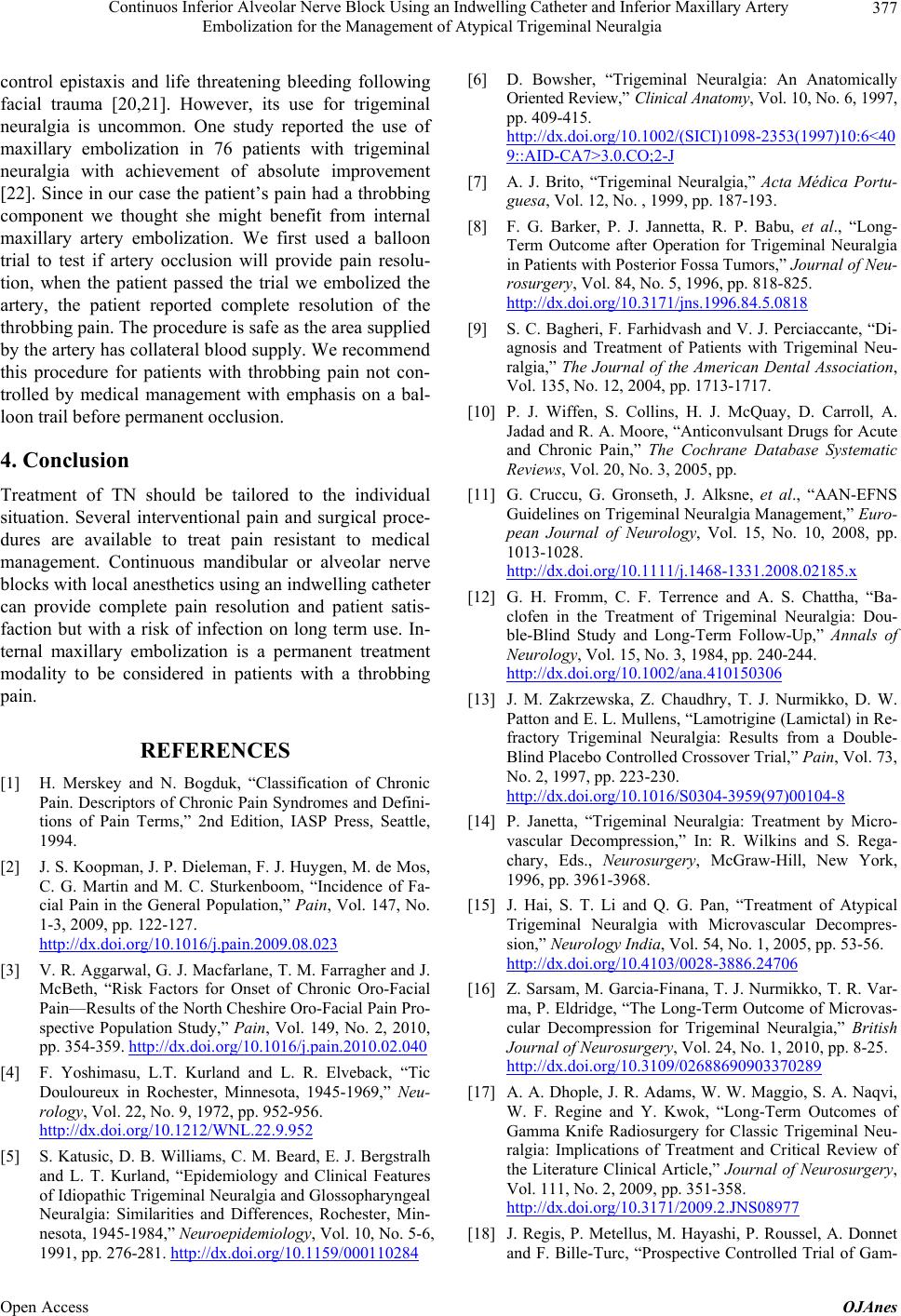
Continuos Inferior Alveolar Nerve Block Using an Indwelling Catheter and Inferior Maxillary Artery
Embolization for the Management of Atypical Trigeminal Neuralgia 377
control epistaxis and life threatening bleeding following
facial trauma [20,21]. However, its use for trigeminal
neuralgia is uncommon. One study reported the use of
maxillary embolization in 76 patients with trigeminal
neuralgia with achievement of absolute improvement
[22]. Since in our case the patient’s pain had a throbbing
component we thought she might benefit from internal
maxillary artery embolization. We first used a balloon
trial to test if artery occlusion will provide pain resolu-
tion, when the patient passed the trial we embolized the
artery, the patient reported complete resolution of the
throbbing pa in. The pro cedure is safe as th e area su pp lied
by the artery has collateral blood supply. We recommend
this procedure for patients with throbbing pain not con-
trolled by medical management with emphasis on a bal-
loon trail before permanent occlusion.
4. Conclusion
Treatment of TN should be tailored to the individual
situation. Several interventional pain and surgical proce-
dures are available to treat pain resistant to medical
management. Continuous mandibular or alveolar nerve
blocks with local anesthetics using an indwelling cath eter
can provide complete pain resolution and patient satis-
faction but with a risk of infection on long term use. In-
ternal maxillary embolization is a permanent treatment
modality to be considered in patients with a throbbing
pain.
REFERENCES
[1] H. Merskey and N. Bogduk, “Classification of Chronic
Pain. Descriptors of Chronic Pain Syndromes and Defini-
tions of Pain Terms,” 2nd Edition, IASP Press, Seattle,
1994.
[2] J. S. Koopman, J. P. Dieleman, F. J. Huygen, M. de Mos,
C. G. Martin and M. C. Sturkenboom, “Incidence of Fa-
cial Pain in the General Population,” Pain, Vol. 147, No.
1-3, 2009, pp. 122-127.
http://dx.doi.org/10.1016/j.pain.2009.08.023
[3] V. R. Aggarwal, G. J. Macfarlane, T. M. Farragher and J.
McBeth, “Risk Factors for Onset of Chronic Oro-Facial
Pain—Results of the North Cheshire Oro-Facial Pain Pro-
spective Population Study,” Pain, Vol. 149, No. 2, 2010,
pp. 354-359. http://dx.doi.org/10.1016/j.pain.2010.02.040
[4] F. Yoshimasu, L.T. Kurland and L. R. Elveback, “Tic
Douloureux in Rochester, Minnesota, 1945-1969,” Neu-
rology, Vol. 22, No. 9, 1972, pp. 952-956.
http://dx.doi.org/10.1212/WNL.22.9.952
[5] S. Katusic, D. B. Williams, C. M. Beard, E. J. Bergstralh
and L. T. Kurland, “Epidemiology and Clinical Features
of Idiopathic Trigeminal Neuralgia and Glossopharyngeal
Neuralgia: Similarities and Differences, Rochester, Min-
nesota, 1945-1984,” Neuroepidemiology, Vol. 10, No. 5-6,
1991, pp. 276-281. http://dx.doi.org/10.1159/000110284
[6] D. Bowsher, “Trigeminal Neuralgia: An Anatomically
Oriented Review,” Clinical Anatomy, Vol. 10, No. 6, 1997,
pp. 409-415.
http://dx.doi.org/10.1002/(SICI)1098-2353(1997)10:6<40
9::AID-CA7>3.0.CO;2-J
[7] A. J. Brito, “Trigeminal Neuralgia,” Acta Médica Portu-
guesa, Vol. 12, No. , 1999, pp. 187-193.
[8] F. G. Barker, P. J. Jannetta, R. P. Babu, et al., “Long-
Term Outcome after Operation for Trigeminal Neuralgia
in Patients with Posterior Fossa Tumors,” Journal of Neu-
rosurgery, Vol. 84, No. 5, 1996, pp. 818-825.
http://dx.doi.org/10.3171/jns.1996.84.5.0818
[9] S. C. Bagheri, F. Farhidvash and V. J. Perciaccante, “Di-
agnosis and Treatment of Patients with Trigeminal Neu-
ralgia,” The Journal of the American Dental Association,
Vol. 135, No. 12, 2004, pp. 1713-1717.
[10] P. J. Wiffen, S. Collins, H. J. McQuay, D. Carroll, A.
Jadad and R. A. Moore, “Anticonvulsant Drugs for Acute
and Chronic Pain,” The Cochrane Database Systematic
Reviews, Vol. 20, No. 3, 2005, pp.
[11] G. Cruccu, G. Gronseth, J. Alksne, et al., “AAN-EFNS
Guidelines on Trigeminal Neuralgia Management,” Euro-
pean Journal of Neurology, Vol. 15, No. 10, 2008, pp.
1013-1028.
http://dx.doi.org/10.1111/j.1468-1331.2008.02185.x
[12] G. H. Fromm, C. F. Terrence and A. S. Chattha, “Ba-
clofen in the Treatment of Trigeminal Neuralgia: Dou-
ble-Blind Study and Long-Term Follow-Up,” Annals of
Neurology, Vol. 15, No. 3, 1984, pp. 240-244.
http://dx.doi.org/10.1002/ana.410150306
[13] J. M. Zakrzewska, Z. Chaudhry, T. J. Nurmikko, D. W.
Patton and E. L. Mullens, “Lamotrigine (Lamictal) in Re-
fractory Trigeminal Neuralgia: Results from a Double-
Blind Placebo Controlled Crossover Trial,” Pain, Vol. 73,
No. 2, 1997, pp. 223-230.
http://dx.doi.org/10.1016/S0304-3959(97)00104-8
[14] P. Janetta, “Trigeminal Neuralgia: Treatment by Micro-
vascular Decompression,” In: R. Wilkins and S. Rega-
chary, Eds., Neurosurgery, McGraw-Hill, New York,
1996, pp. 3961-3968.
[15] J. Hai, S. T. Li and Q. G. Pan, “Treatment of Atypical
Trigeminal Neuralgia with Microvascular Decompres-
sion,” Neurology India, Vol. 54, No. 1, 2005, pp. 53-56.
http://dx.doi.org/10.4103/0028-3886.24706
[16] Z. Sarsam, M. Garcia-Finana, T. J. Nurmikko, T. R. Var-
ma, P. Eldridge, “The Long-Term Outcome of Microvas-
cular Decompression for Trigeminal Neuralgia,” British
Journal of Neurosurgery, Vol. 24, No. 1, 2010, pp. 8-25.
http://dx.doi.org/10.3109/02688690903370289
[17] A. A. Dhople, J. R. Adams, W. W. Maggio, S. A. Naqvi,
W. F. Regine and Y. Kwok, “Long-Term Outcomes of
Gamma Knife Radiosurgery for Classic Trigeminal Neu-
ralgia: Implications of Treatment and Critical Review of
the Literature Clinical Article,” Journal of Neurosurgery,
Vol. 111, No. 2, 2009, pp. 351-358.
http://dx.doi.org/10.3171/2009.2.JNS08977
[18] J. Regis, P. Metellus, M. Hayashi, P. Roussel, A. Donnet
and F. Bille-Turc, “Prospective Controlled Trial of Gam-
Open Access OJAnes